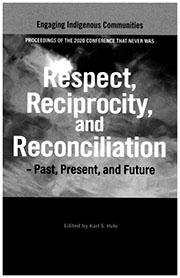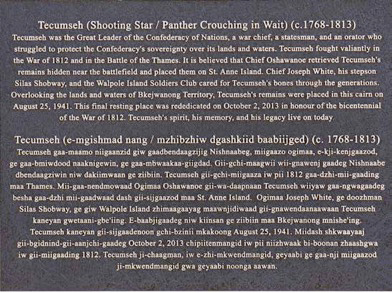Aboriginal Connections to Race, Environment and Traditions
| Editors: |
Overview
|
|
| Rick Riewe and Jill Oakes | ||
 |
This book includes 14 papers written by experts in the social sciences, health sciences and humanities exploring connections between: • Internment of Japanese Canadians and colonization of Canada’s Aboriginal Peoples • Nature in the literary works of Louise Erdrich • Cosmology and Inuit clothing • Aboriginal students and faculty experiences with distance education • First Nations and Black American soldiers • The Mi’kmaq Nation of Newfoundland, the Charter of Rights and Freedoms, and Nicolas Denys (1598-1688) • The Baldoon Experiment and the Sustainability of Bkejwanong Territory (Walpole Island, Ontario) • Wild rice harvesters and marketers in northern Manitoba • Past and present First Nation’s government • Women and self-government • Aboriginal Community and University ‘Partnership’ • Culture and health in the Urban Aboriginal Diabetes Project (UADP) |
|
| Table of Contents (.pdf) | ||
|
154 pages; Price $20.00 |
Aboriginal Cultural Landscapes
| Editors: |
|
|
| Jill Oakes, Rick Riewe, Yale Belanger, Sharon Blady, Kelly Legge, and Patsy Wiebe | ||
| Overview | ||
 |
This exciting volume includes 35 refereed chapters written by Elders, poets, artists, scientists, politicians, and environmentalists. Chapters cover relationships to the land, Sacred places, traditional knowledge, Aboriginal imagination, therapeutic landscapes, identity and repatriation, ethics, Metis studies, historical interactions of Inuit, climate change, food webs,and literary works. |
|
| Table of Contents (.pdf) | ||
| 347 Pages, Price: $25.00 | ||
Beluga Co-management: perspectives from Kuujjuarapik and Umiujaq
| Researcher: Robin Gislason Principal Investigators: Rick Riewe, Jill Oakes |
|
|
| Overview | ||
 |
The Inuit of Nunavik have always harvested the beluga whale for subsistence purposes; this harvest is of great social, cultural, and economic importance. In the 1800s, the Hudson Bay Company ran a commercial Whaling post at the mouth of the Great Whale River, simultaneously, decreases in the eastern Hudson Bay beluga summer stock were observed. By the 1980s, the Department of Fisheries and Oceans began suggesting that the Inuit subsistence harvest was too high for the beluga population to recover. They implemented a management strategy, including harvest quotas and seasonal and regional closures. Inuit of Nunavik have very little say in this designed management strategy and strongly recommend changes to the plan. |
|
| Table of Contents (.pdf) | ||
| 55 pages (colour pictures), Price: $20.00 |
The Buckskin Ceiling: A Native Perspective on Native Art Politics
| Alfred Young Man | |
 |
About the Author Alfred Young Man, Ph. D. (Eagle Chief) is a Cree enrolled member of the Chippewa-Cree Indian Reservation in Rocky Boy, Montana and Professor Emeritus of the University of Lethbridge and University of Regina. Born in Browning, Montana on the Blackfeet Indian Reservation, his paternal and maternal Cree grandparent’s were from the Duck Lake area reserves in Saskatchewan and the Ermineskin and Cold Lake reserves in Alberta. Young Man has had numerous paint- ings, articles, essays, book reviews and art critiques published in art catalogues, newspapers, magazines, on internet web pages, and in refereed journals. He has travelled extensively throughout the world presenting at conferences and universi- ties in Japan to South Africa to Paris to Rome to Yale to Australia, Germany, Mexico, California, Sweden, Finland, Canada, the United States and so forth. |
| Table of Contents (.pdf) | |
| Price: $15.00 |
Climate Change: Linking Traditional and Scientific Knowledge
| Editors Rick Riewe and Jill Oakes |
|
|
| Overview | ||
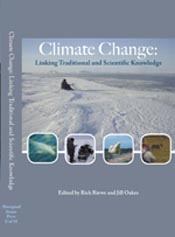 |
This book is a refereed publication and includes papers written by over 50 community experts and scientists addressing theoretical concerns, knowledge transfer, adapting to climate change, implications of changing weather, water and ice conditions for northerners and wildlife, and the impact of climate change on tourism, fire, and industrial development. Northern communities, politicians, managers, policy makers, scientists, and schools will find valuable insights gained by exploring linkages between traditional and scientific knowledge in the north. |
|
| Table of Contents (.pdf) | ||
| 285 pages; Price $25.00 |
Coats of Eider
| Jill Oakes |
|
|
| Overview | ||
 |
“Coat of Eider” describes the production process, environmental influences, and cultural significance of Eider skin clothing made by Inuit from Sanikiluaq located on the Belcher Islands in Hudson Bay. In addition, a section by Dr. Thomas Stone from the Canadian Conservation Institute discusses bird skin clothing from a conservator’s perspective. This publication includes illustrations, photographs, text in Inuktitut, French and English, and references, including oral knowledge from Inuit seamstresses and relevant literature. |
|
| Table of Contents (.pdf) | ||
| 28 Pages, Price: $6.00 Or purchase this book with Inuit Annuraangit for $10.00 |
Colonial Encounters in the Fur Trade
| Robert Wesley Heber | |
 |
About the Author We can always learn something from another’s personal experiences when the story of those experiences is told honestly. We can learn even more when those personal experiences deal with a significant piece of history. And we can learn still more when those experiences are situated within a critical and analytic perspective. Wes Heber’s experiences as a clerk for the Hudson’s Bay Company in the dying days of the fur trade, as recounted in his book Colonial Encounters in the Fur Trade offers teachings on all three levels. Heber tells the story of his experiences working for the Hudson’s Bay Company as a ‘bay boy’ with honesty, humour, and refreshing detail. He is not trying to burnish his image, either in the way he describes his work and responsibilities or in the way he puts forth as a storyteller. We learn about the inner workings of the Hudson’s Bay Company in its dealings with First Nations peoples through the eyes of Heber as a naïve young man seeking adventure, and often finding realities. Anecdote after anecdote, event after event unfolds and we get a close up insider’s view of the conditions of the time. Colonial Encounters in the Fur Trade brings you into a world, no longer existing, but whose legacy of abuse continues. Reading this book can help to build commitment to ending that legacy for the benefit of all. |
| Table of Contents (.pdf) | |
| Price: $15.00 |
Connective Pedagogy Elder Epistemology, Oral Tradition and Community
| Rosemary Ackley Christensen and Lisa M. Poupart |
|
|
| Overview | ||
 |
Indigenous teaching methodology based on the Seven Principles reflecting traditional knowledge within the holistic world-view, balanced with the pervasive Western world-view of the Academy, is explored, deliberated and echoed in Connective Pedagogy. | |
| Table of Contents (.pdf) | ||
| 128 pages, Price: $15.00 |
Exploring the Sacred
| Guest Editors: Suzanne Galbraith, Leigh Bryant Authors: Marvic Abarra, Leigh Bryant, Emily English, Marie-Diana Folde, Trevor Friesen, Lea Grzenda, Ashleigh Hall, Lauren Hayhurst, Breanne Jack, Pamela Johnson, Pamela Klassen, Megan Krohn, Chris Piasta, Amy Smith, Amanda Totté |
|
|
| Overview | ||
 |
Exploring the Sacred examines contemporary and historical landscapes, events and values. An increased understanding of other peoples’ views of sacred is gained by exploring a variety of abridged case studies: from prairie potholes to Vimy Ridge, Indigenous traditions to historical sites, and the Holy Ganges River to Spanish bullfighting.
|
|
| Table of Contents (.pdf) | ||
| 66 pages; Price $15.00 |
Environmental Change and Off-Road Transportation in Churchill, Manitoba
| Researcher: Justin Gilligan Chief Editors: Rick Riewe, Jill Oakes |
|
|
| Overview | ||
 |
“Environmental Changes and Off-road Transportation in Churchill, Manitoba”by Justin Gilligan is a single authored, refereed community report. This book links harvesters’ traditional and local knowledge observations with scientific knowledge on the implications of Environmental Change and Off-road Transportation in Churchill, MB. Based on Justin Gilligan’s University of Manitoba Master of Arts thesis of the same name (2007), this community report was prepared for the community of Churchill and others who may find useful the observations on environmental change made by harvesters: hunters, trappers and fishers, in the Churchill region of Manitoba. Hunters, trappers and fishers are experts on local environmental change; rather than testing or validating traditional and local knowledge against scientific knowledge, observations from both knowledge systems are presented here in parallel to gain a more holistic understanding of the impacts and opportunities that face harvesters in Churchill area. |
|
| Table of Contents (.pdf) | ||
| 37 pages, Price: $15.00 |
Facets of the Sacred
| Editors: Rick Riewe, Jill Oakes |
|
|
| Overview | ||
 |
Since time immemorial human being have attached sacred meaning to many aspects of human existence. This collection of works examines various facets of this meaning through examination of different beliefs, celebrations, traditions and places of spiritual significance found throughout the glove. Human relationships with sacred landscapes, sacred regions in conflict and the sacred nature of everyday activities, such as eating are explored in the contexts of (but not exclusive to) Canadian Aboriginal peoples, Indigenous Hawaiian peoples, the Sámi of Scandinavia and the three Abrahamic faiths. As Joy MacLean eloquently states in her chapter “Locating the Sacred”, it is hoped that “…through research such as this it is possible to create ‘common ground’ – to increase the area in which our cross-cultural understanding overlap and can be shared” | |
| Table of Contents (.pdf) | ||
| 88 pages; Price $20.00 |
Gambling and Problem Gambling in First Nations Communities
| Principal Investigators: Jill Oakes |
|
|
| Overview | ||
 |
This book is the first book to share perspectives from First Nations in northwestern Ontario. This community based report increases one's understanding of the issues, provides possible solutions, and makes recommendations based on first-hand insights. It includes participatory-action items, information for community newsletters, and answers to frequently asked questions that can be of use to individuals and families, Health Directors, Additions Workers, Recreation Officers and others interested in gambling issues. Participants found it useful to learn of experiences in recommendations similar to their own by reading this report. Participants said: |
|
| Table of Contents (.pdf) | ||
| 160 pages; Price $20.00 |
Grasslands on the Manitoba Escarpment
| Leanna Fehr |
|
||
|
|
|||
|
Introduction
|
|||
| Table of Contents (.pdf) | |||
| 19 pages; Price $10.00 |
Hudson Bay Regional Research
| Researcher: Linda Chow and Kelly McKay Principal Investigators: Jill Oakes and Rick Riewe |
|
|
| Overview | ||
 |
“Hudson Bay Regional Research” This book provides an overview of research being conducted in the Hudson Bay region. Researchers sub- mitted summaries of their work creating this unique snapshot of what research is taking place in the region. Policy makers, non-government organizations, local communities and academia may find this useful in order to understand, coordinate and create linkages between research projects. |
|
| Table of Contents (.pdf) | ||
| 355 pages, Price: $25.00 |
Indigenous Education and International Academic Exchange
| Robert Wesley Heber and Xuefang Peng |
|
|
| Overview | ||
 |
Indigenous Education and International Academic Exchange addresses challenges and achievements in education for Indigenous people within the contest of international academic exchange. This comparative analysis of Indigenous education in Canada, China, and Thailand furthers our understanding of specific education needs for Indigenous people, and how those needs are being met. |
|
| Table of Contents (.pdf) | ||
| 174 pages, Price: $15.00 |
Indigenous Voices and Spirit Memory
| David T. McNab, Ute Lischke, Patsy McArthur, Paul-Emile A. McNab, Maureen Riche, Katie Peterson, and Stephane McLachlan |
|
|
| Overview | ||
 |
Indigenous Voices and Spirit Memory explores the meaning and importance of traditional knowledge passed from generation to generation. It is the core that unites Mindscape and Landscape. Powerful examples of the significance of voices and spirit memory are drawn from Indigenous film, documentaries, literature, mapping, humour and genealogy. |
|
| Table of Contents (.pdf) | ||
| 76 pages, Price: $15.00 |
Inviting Hope: An Exposé on Suicide Among First Nations, Inuit and Métis Peoples
| Marcel Anthonypillai, Assembly of Manitoba Chiefs, Alison Kiawenniserathe Benedict, Carla Cochrane, Kavita Kandhai, Kathi Avery Kinew, Jocelyn Langlois, Amanda Meawasige, Krishna Modupalli, Miriam Thomson, Leona Star, Stephanie Sinclair, and Satwinder Singh |
|
|
| Overview | ||
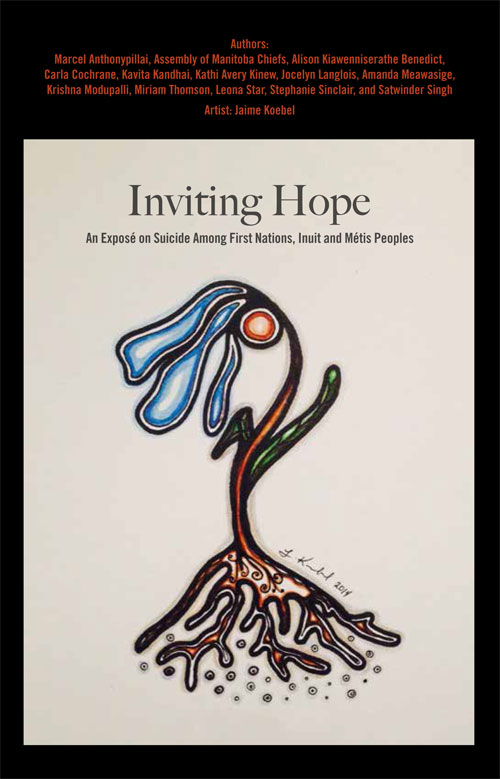 |
Inviting Hope: An Exposé on Suicide Among First Nations, Inuit and Métis Peoples creates awareness, develops allies and inspires change, to better the social, health, and political conditions impacting Aboriginal Peoples. It is essential for allies to stand with Aboriginal Peoples in the face of social injustice to assist in making change for a more equitable and just Canada. Inviting Hope...provides valuable insights on the role social injustices and systemic discrimination have in producing inequitable health conditions, which lead to suicide among Aboriginal Peoples nation-wide. To prevent this, contextual understanding of concepts of suicide, systemic discrimination, and oppression are integral to the treatment and health promotion of Canadian Aboriginal Peoples. |
|
| Table of Contents (.pdf) | ||
| 90 pages, Price: $15.00 |
Inuit Annuraangit: Our Clothes
| Jill Oakes |
|
|
| Overview | ||
 |
A Travelling Exhibition of Inuit Clothing “Inuit Annuraangit” is a lavishly illustrated introduction to culturally distinct clothing styles from each of the main regions of the Canadian Arctic. The text is written in Inuktitut and English, and includes numerous direct quotes from Inuit seamstresses renown for their role in maintaining the ancient tradition of passing on traditional Inuit knowledge through clothing styles and production procedures. References include oral knowledge from Inuit seamstresses and relevant literature. |
|
| Table of Contents (.pdf) | ||
| 24 Pages, Price: $6.00 Or purchase this book with Coats of Eider for $10.00 |
My Silent Drum
| Ovide Mercredi |
|
|
| Overview | ||
 |
I wrote these words, in a style that is free, based on an idea that becomes a short story. It may not be poetry as expressed from the perspective of Euro-Canadian literature, the words and thoughts are mine as one Indigenous voice drumming ...silently. I try to convey a point of view that may not be readily available to Canadian contemporary expressions of our human experience. Nonetheless, this little book is like a silent drum that only the listener can hear, understand, and hopefully relate to the story. |
|
| Table of Contents (.pdf) | ||
| 202 Pages, Price: $20.00 | ||
 "Poetry has become an extension of my advocacy for fairness and justice." - Ovide Mercredi Ovide Mercredi biography: Ovide Mercredi is a highly respected lawyer, negotiator, former National Chief of the Assembly of First Nations, lecturer, activist, artist, author and poet. Of Cree descent, Mercredi was born in 1946 into a traditional trapping, hunting and fishing lifestyle in Misipawistik Cree Nation (Grand Rapids), Manitoba. He went on to pursue a career in justice, earning his law degree from the University of Manitoba in 1977. He was one of the student leaders who established the first Native Students’ Association in Canada, and the Indian and Eskimo Student Centre. In 1989, he was elected Regional Chief of the Assembly of First Nations for Manitoba. He was a key strategist in defeating the Meech Lake Accord, and he played an integral role in resolving the Oka Crisis. He was elected National Chief for the Assembly of First Nations in 1991. He was re-elected in 1994 and served until 1997. As National Chief, Mercredi played a major role in the Charlottetown Accord constitutional discussions and addressed the United Nations in both Geneva and New York. Mercredi became Chief of the Misipawistik Cree Nation and served his community from 2005 to 2011. During his tenure, he negotiated an agreement with Manitoba Hydro that will result in a $100 million contribution over 50 years for new housing and renovations. He also secured new funds for adult learning and training, a community-governed health centre and greenhouse project, and brought in modern amenities like a gas station, community store, coffee shop and improved communications. In 2006, Mercredi was invested with the province’s highest honour, the Order of Manitoba. He was nominated by the Government of India for the Ghandi Peace Prize and has received honorary degrees from Bishop’s University, St. Mary’s University and Lethbridge University. In 2007, Mercredi was installed as the first chancellor of the University College of the North, which serves students above the 53rd parallel. He received a Distinguished Alumni Award from the University of Manitoba in 2013. Over the past several years, Mercredi has been involved at the University of Manitoba through numerous speaking engagements and has provided advice to the Dean, Faculty of Social Work, on Indigenous knowledge and teachings as it relates to Child and Family Services. Mercredi has also provided advice and support to the University of Manitoba’s President and to the Executive Lead, Indigenous Achievement, on a full range of issues. He currently sits on the Board of Directors of Canadians for a New Partnership, which is working to build relations between First Peoples and all Canadians. My Silent Drum is his first book of poetry. |
||
Native Voices in Research
| Editors: Jill Oakes, Rick Riewe, Kimberley Wilde, Alison Edmunds, Alison Dubois. |
|
|
| Overview | ||
 |
This book explores innovative ways of learning based on traditional Aboriginal Peoples' ways of knowing. Authors include Aboriginal practitioners, academics, and community leaders in the fields of anthropology, community health, dentistry, education, history, nursing, linguistics, literature, political sciences, economic development, and women' studies. The book, which includes 32 papers on 347 pages, has five sections: 1. Health and Education Presents Aboriginal Peoples' perspectives on the meaning of "place or home", collaborative field work, distance education nursing programs, the meaning of cancer, and university life. 2. Colonization Presents colonization through changes in Mi'kmaq-Acadian alliances, Anglican missionaries, use of Guarani by indigenous peoples in Paraguay, and the role of Coyote! 3. Ethics and Methodology Introduces ethics and methods based on Aboriginal traditions highlighting experiential learning, storytelling, relationship building, and inclusive learning. 4. Consultation and Public Policy Questions policies in Canada and India, provides advice on effective consultation, and discusses the essential need for respect in presenting traditional ecological knowledge. 5. Traditional Knowledge in Planning Shares examples of how community-based research was used to learn invaluable perspectives on topics ranging from Arctic climate change, lake sturgeon and moose, northern economic development, Greenland fisheries, and indigenous potato farmers in Bolivia |
|
| Table of Contents (.pdf) | ||
| 347 Pages, Price: $25.00 |
On Thin Ice
| Chief Editors: Louis Fortier, David Barber and Josée Michaud |
|
|
| Overview | ||
 |
Louis Fortier, Canada Research Chair on the Response of Arctic Marine Ecosystems to Climate Change: "The Arctic in on its way to a new climatic equilibrium. Perennial sea ice, permafrost and glaciers are vanishing at unexpected rates. Combined with rampant modernization, warming has profound impacts on the geopolitics, economy, health, and societies of the Canadian Arctic. The Canadian Arctic Shelf Exchange Study (CASES) represents the largest single effort ever to understand the response of the Arctic Ocean biota to climatic change. Over a complete annual cycle, 210 scientists from 8 countries studied all aspects of the Beaufort Sea ecosystem. This compendium summarizes their findings in a form relevant to policy makers, community members, and managers." |
|
| Table of Contents (.pdf) | ||
| 215 pages; Price $50.00 |
Opaskwayak Cree Nation Guide to the Wetlands of the Saskatchewan River Delta
| Alli Morrison and Iain Davidson-Hunt |
|
|
| Overview | ||
 |
“Opaskwayak Cree Nation Guide to the Wetlands of the Saskatchewan River Delta” is funded by Ducks Unlimited through contributions made by Manitoba Hydro. Information and perspectives presented in this book are the sole opinions of the authors and not those of the Funding agencies, corporations, University of Manitoba, or Aboriginal Issues Press, its employees, editors and volunteers. All profits from the sale of this book are used to support the refereed publication of Aboriginal scholarship and the Aboriginal Issues Press Scholarship Endowment Fund at the University of Manitoba. |
|
| Table of Contents (.pdf) | ||
| 53 pages, Price: $15.00 |
Pikangikum Cultural Landscape Documentation Guide
| Iain Davidson-Hunt and R. Michael O'Flaherty |
|
|
| Overview | ||
 |
“The vision of Pikangikum people for research in support of the Whitefeather Forest Initiative is that it will enhance their ability to take care of the land and resources in the Traditional Territories of Pikangikum First Nation… This vision honours the teachings and wisdom of Pikangikum Elders that support the effective care and protection of the diversity of life on the land. This vision supports dialogue and working together to carry out research on the basis of respect and in a manner that will bring together the best of different knowledge traditions.” |
|
| Table of Contents (.pdf) | ||
| Price: $15.00 |
Residents' Perspectives on the Churchill River
| Researcher Joel Edye-Rowntree Principal Investigators: Jill Oakes and Rick Riewe |
|
|
| Overview | ||
 |
The lower Churchill River was and still is a very important part of the psyche of Churchill residents, being used for recreational purposes, such as fishing and boating and transportation routes for hunting and trapping. Residents’ spatial orientation is based on the river, “upriver” and “across the river” are terms used in everyday language. |
|
| Table of Contents (.pdf) | ||
| 110 Pages; Price $15.00 |
Respect, Reciprocity, and Reconciliation - Past, Present and Future
Sacred Landscapes
| Chief Editors: Jill Oakes, Rick Riewe, Rachel ten Bruggencate, and Ainslie Cogswell |
|
|
| Overview | ||
 |
Sacred Landscapes provides the reader with an opportunity to explore the sanctity of our environment, illustrating the connection between landscapes and mindscapes. First Nations perspectives are presented, as well as perspectives from non-Aboriginal authors working with the Inuit, Métis, and the First Nations as co-researchers, through the stories told by ancient artifacts, and with literature and videos produced by Aboriginal authors. Papers explore four perspectives of Sacred Landscapes: sanctity of resources, the meaning of ancient sites and ceremonies today, theoretical examination of landscapes and mindscapes, and examples of protecting and coping with change. Authors discuss the importance of ancient cultural, spiritual and physical meaning of landscapes and mindscapes to Indigenous populations. |
|
| Table of Contents (.pdf) | ||
| 240 pages, Price: $20.00 |
Seeing the World with Aboriginal Eyes
| Brian Rice |
|
|
| Overview | ||
 |
Seeing the World with Aboriginal Eyes - this four directional perspective on human and non-human values, cultures and relationships on Turtle Island provides a comprehensive presentation of various North American Aboriginal world views and spiritual understandings. Including: |
|
| Table of Contents (.pdf) | ||
| 91 pages; Price $20.00 |
Stitching Stories: Interpretations of Material Culture
| Chief Author: Amy Cherpako |
Design and Layout: Joshua Paull |
Design Editor: Sandra Froese |
Assistant Editors: Elaina Waters, Ji Yun Zhang |
Authors: Tahmid Tashad, Ahamed, Tolgonai Artykbai Kyzy (Ayla), Melissa Bergen, Amy Cherpako, Qi Cui, Noah Doornbos, Camille Forbes, Celine A. Froese, Sandra Froese, Soomin Han, Taylor Kauppila, Hayden Keogh, Niko Koncan, Marediya Rabbil, Harrison Mason, Efua Oribhabor, Hannah Patton, Joshua Paull, Garett Rekrut, Emily Rose Savoie, Nadia Schimnowski, Thomas Tower, Elaina Waters and Ji Yun Zhang |
| Overview | ||||
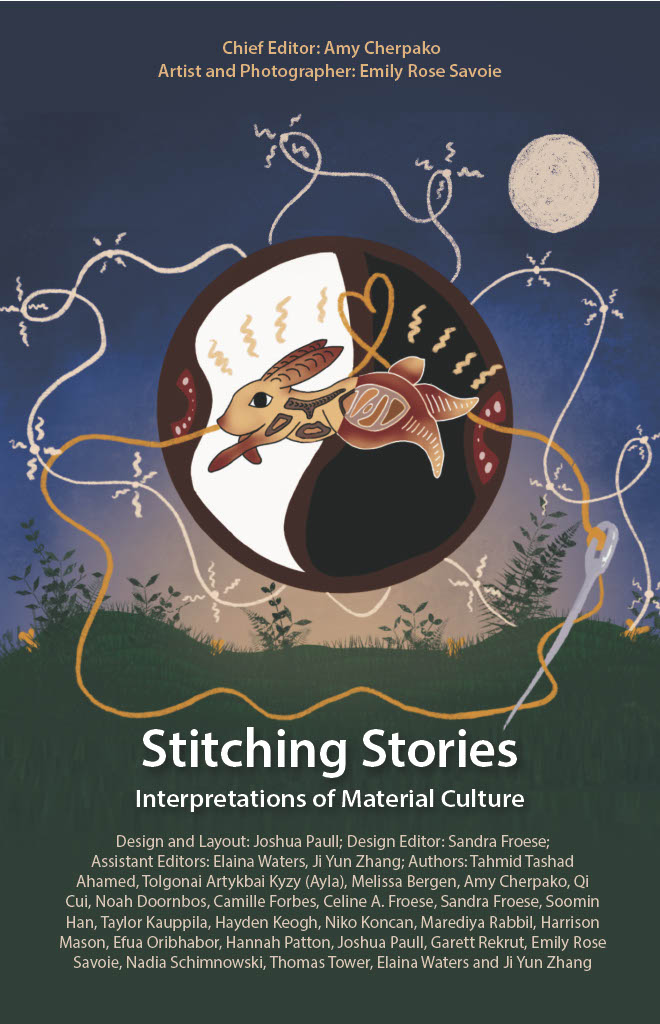 |
A group of university students defined ‘sacred land’ as ‘a way of life’, all encompassing the spiritual, cultural, historical, and contemporary aspects. Therefore, a particular sacred site or object is the tangible that tells the story of a way of life. It is a beautiful sentiment that 24 people from all over the world had the opportunity to come together and use an Inuit-style mitten pattern as the impetus to gain an understanding of sacred lands. We learn from one another through discussion and the process of creating. We share our personal stories and our knowledge. We offer personalized ways of life through cultural differences. |
|||
| Table of Contents (.pdf) | ||||
| 48 Pages Price: $20 |
Survivance & Reconciliation: 7 Forward / 7 Back
| 2015 Canadian Indigenous Native Studies Association Conference proceedings | ||
| Edited by Karl S. Hele |
|
|
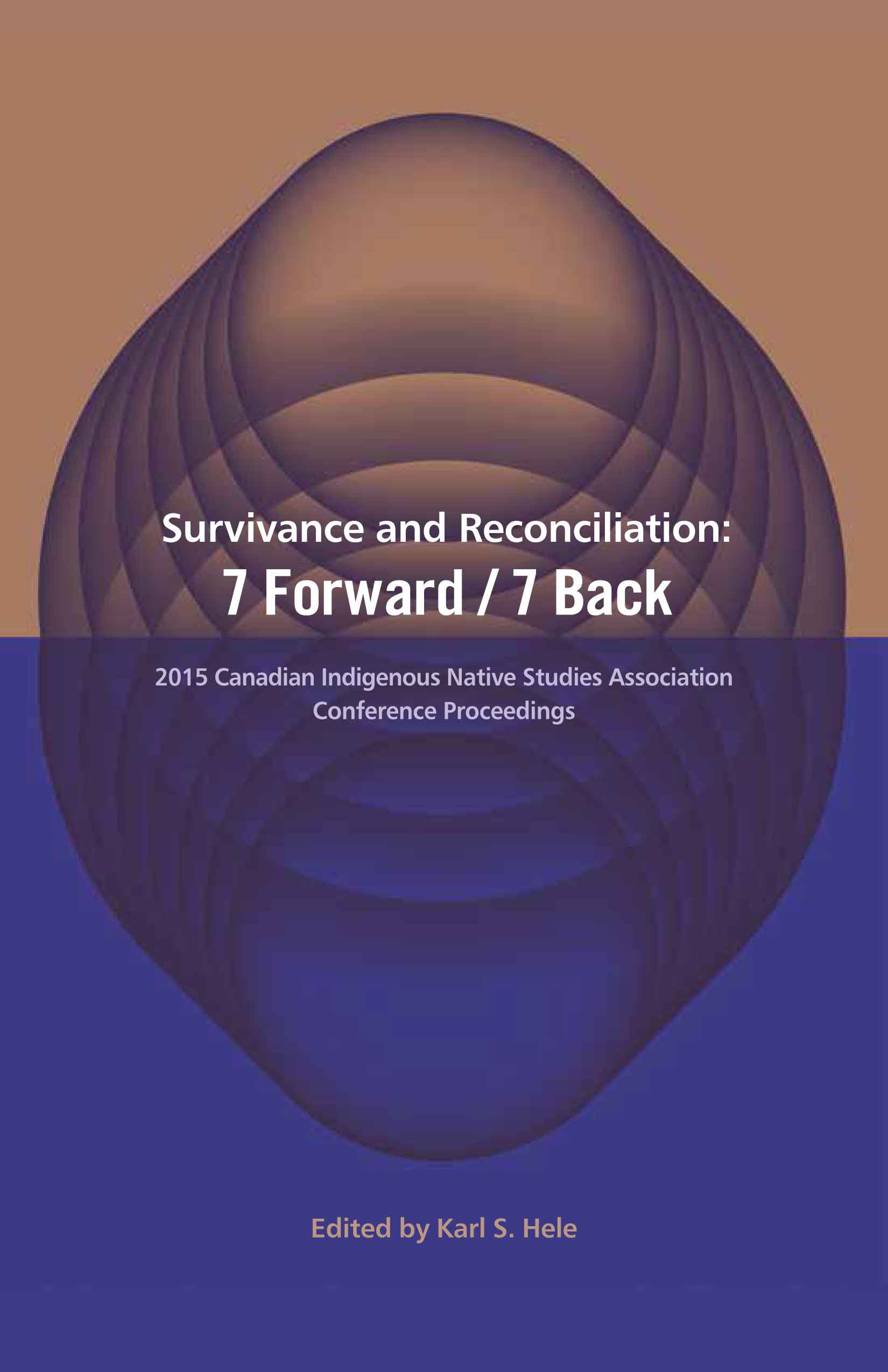 |
We have survived despite prolonged efforts of erasure by colonial states. Our survivance demands reconciliation. The reconciliation process must look back- wards and forwards to determine a proper path for the future. In 2015, the Canadian Indigenous/Native Studies Association reinforced this by re-launching its annual conference with the dual themes of survivance and reconciliation. The articles within this collection represent a beginning of discussions and calls for action. |
|
| Table of Contents (.pdf) | ||
| Price: $20.00 | ||
Tecumseh's Vision
| Indigenous Sovereignty and Borders Since the War of 1812 | ||
|
|
||
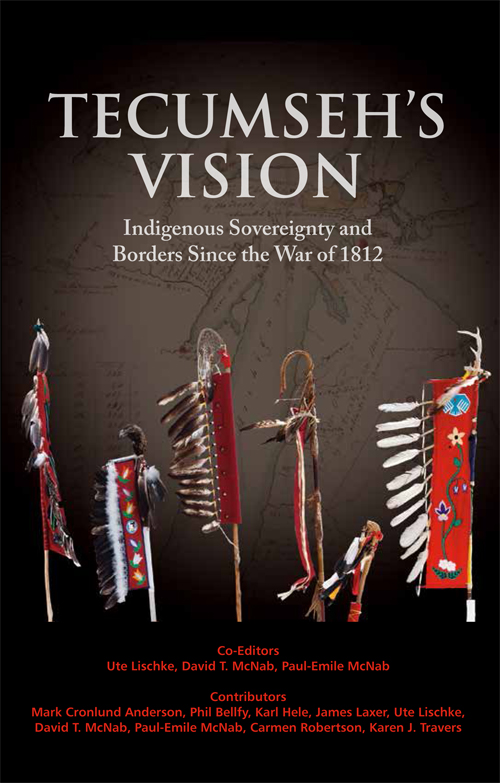 |
Co-Editors: Ute Lischke, David T. McNab, Paul-Emile McNab Contributors: Mark Cronlund Anderson, Phil Bellfy, Karl Hele, James Laxer, Ute Lischke, David T. McNab, Paul-Emile McNab, Carmen Robertson, Karen J. Travers |
|
|
|
||
| Table of Contents (.pdf) | ||
| 178 Pages, Price: $20.00 | ||
Voices from the Dorms
| Jill Oakes & Rick Riewe |
|
|
| Overview | ||
 |
Qualicum Beach School was created in 1935 by Ivan and George Knight with financial support from England. After instructing boys from a wide range of circumstances and locales, the school closed in 1970. Alumni, staff, family, photographs and archival collections provide unique insights on the boarding school experience, including the staff, curriculum, discipline, sports, cadets, theatre, heart wrenching loneliness and mischievous pranks. |
|
| Table of Contents (.pdf) | ||
| 226 pages; Price $40.00 |
Working with Indigenous Elders
| Jonathan H. Ellerby |
|
|
| Overview | ||
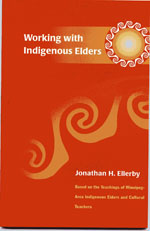 |
This Book is a reprint of “Working with Aboriginal Elders”. The content is exactly the same except for the word “Aboriginal” has been changed to ”Indigenous” in the title and throughout the book. Based on the teachings and experience of a select group of local Elders and Cultural Teachers, this manual addresses common and widespread areas of institutional conflict and concern in a manner that identifies solutions and provides information necessary for researchers, students, consultants, health care professionals and program administrators to work effectively with Elders. |
|
| Table of Contents (.pdf) | ||
| 73pages; Price $15.00 |
Written in Mitten
| Chief Editors: Stefano Strapazzon, Natalie Baird, Erika Larsen, and Chantal Pawluk Authors: Natalie Baird, Ruth Bergen, Chelsea Dutkiewich, Elias Fiebelkorn, Evangelin Francis, Michael Hockett, Jordan Hoff, Taylor Jones-Arason, Jenna Klause, Chris Komishon, Erika Larsen, Amy Lee, Dylan Lyng, Brendon MacLeod, Danny Militano, Veronica Moar, Ben Olson, Chantal Pawluk, Holly Schroeder, Stefano Strapazzon, Matthew Warning, and Alexandra Yuzwa
|
||
| Overview | ||
 |
Written in Mitten |
|
| Table of Contents (.pdf) | ||
| 56 pages, Price: $15.00 | ||
After the Mill
| Mike Aiken |
|
|
| Overview | ||
 |
“After the Mill: From confrontation to cooperation” is a collection of current affairs occurring within Treaty 3 between 2003 and 2010. The collection is clustered into the following sub-sections: ‘struggle for cooperation’, ‘forestry in crisis’, ‘sharing the forest’, ‘change in governance’, ‘building new relation- ships’, and concludes with ‘investing in the future’. Each section highlights an important shift towards developing cooperative agreements between First Nations and non-Aboriginal governing bodies. |
|
| Table of Contents (.pdf) | ||
| Price $15.00 |
Contemplating Sacred Space: From the Tangible to the Conceptual
| Editors: Tanya Rideout, Rosemary Dohan, Suzanne Galbraith, Jill Henirichs and Lori MacKay Contributors: Erin Anderson, Kathleen Brown, Rosemary Dohan, Kipp Fenell, Mark Gallant, Jill Heinrichs, Mark Intertas, Lori MacKay, Glen McDonald, Jarrod Miller, Dean Rennie, Tanya Rideout, Garth Sutton and Garrett Watson |
|
|
| Overview | ||
 |
"Contemplating Sacred Space: From the Tangible to the Conceptual": perspectives presented in this book are the sole opinions of the authors and not those of the University of Manitoba, Aboriginal Issues Press, its employees, editors and volunteers. All profits from the sale of this book are used to support the refereed publication of Aboriginal scholarship and the Aboriginal Issues Press Scholarship Endowment Fund at the University of Manitoba. |
|
| Table of Contents (.pdf) | ||
| 81 pages, Price: $15.00 |
This is Indian Land
| Edited by Karl S. Hele |
|
|
| Overview | ||
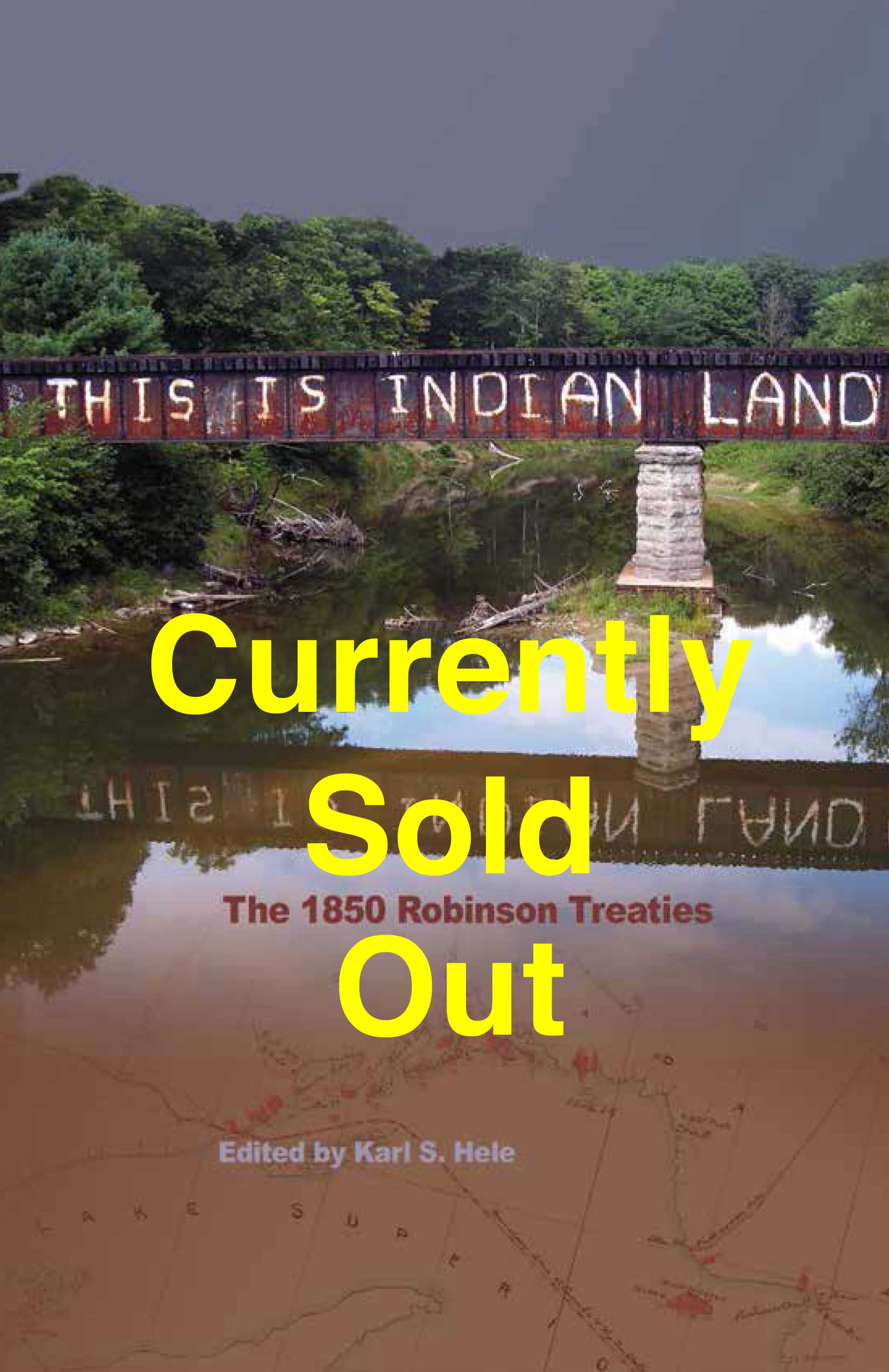 |
Located on the Garden River CP Rail Bridge with its message “THIS IS INDIAN LAND”, serves as a powerful reminder that these lands belong to a First Nation. While the sign may literally rest on Indian land, it speaks to the reality often forgotten by mainstream society, that it exists on lands currently or once owned by various First Nations. This collection of articles about the 1850 treaties seeks to remind and engage people in a conversation about the lands and waters they share. |
|
| Table of Contents (.pdf) | ||
| Price: $20.00 |


